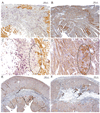Mechanisms of Post-Infarct Left Ventricular Remodeling
- PMID: 18690295
- PMCID: PMC2504336
- DOI: 10.1016/j.ddmec.2007.12.006
Mechanisms of Post-Infarct Left Ventricular Remodeling
Abstract
Heart failure secondary to myocardial infarction (MI) remains a major source of morbidity and mortality. Long-term outcome after MI can be largely be defined in terms of its impact on the size and shape of the left ventricle (i.e., LV remodeling). Three major mechanisms contribute to LV remodeling: 1) early infarct expansion, 2) subsequent infarct extension into adjacent noninfarcted myocardium, and 3) late hypertrophy in the remote LV. Future developments in preventing post-MI heart failure will depend not only on identifying drugs targeting each of these individual mechanisms, but also on diagnostic techniques capable of assessing efficacy against each mechanism.
Conflict of interest statement
Figures


References
-
- Rosamond W, et al. Heart Disease and Stroke Statistics--2007 Update: A Report From the American Heart Association Statistics Committee and Stroke Statistics Subcommittee. Circulation. 2007;115(5):e69–e171. - PubMed
-
- Mann DL. Mechanisms and models in heart failure: A combinatorial approach. Circulation. 1999;100(9):999–1008. - PubMed
-
- Mann DL, Bristow MR. Mechanisms and models in heart failure: the biomechanical model and beyond. Circulation. 2005;111(21):2837–2849. - PubMed
-
- Cohn JN. Structural basis for heart failure. Ventricular remodeling and its pharmacological inhibition. Circulation. 1995;91(10):2504–2507. - PubMed
-
- Tiyyagura SR, Pinney SP. Left ventricular remodeling after myocardial infarction: past, present, and future. Mount Sinai Journal of Medicine. 2006;73(6):840–851. - PubMed
Grants and funding
LinkOut - more resources
Full Text Sources
Other Literature Sources
